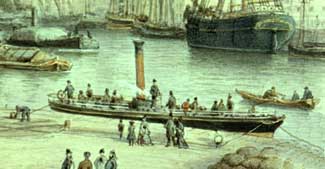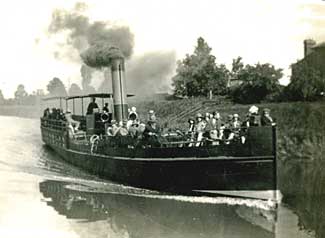 The
Original Wave and Lapwing The
Original Wave and Lapwing
The Wave
was brought up from Bristol by John Francillon to start running
regular services on the canal in 1852. It was 87ft long and was
licenced to carry 258 passengers, although it was only required
to have two lifebelts! The Lapwing arrived a year later,
having been built at the Neath Abbey Ironworks with a length of
65ft. The two boats ran three times a day in each direction during
the summer and twice daily in winter. As well as those travelling
for leisure or for shopping, early passengers included merchants
and ship brokers visiting Sharpness to meet arrivals, sailors joining
their ships at the last moment before departure and a growing number
of labourers who worked at Sharpness during the week and only returned
to Gloucester at the weekends. The boats were also used occasionally
for special excursions with musical entertainment and for the annual
inspections of the canal by the Canal Company committee and their
guests.
 Replacement Boats Replacement Boats
In 1890, the Wave
was replaced by a new boat built at Cardiff to the design of William
Sisson of Gloucester who also supplied the engine and boiler. It
was 85ft long, mainly on the lines of the old boat, and it was certified
to carry 242 people. The Lapwing was replaced two years later,
both new vessels taking the names of their predecessors. Both vessels
had a first class cabin astern of a central engine room and a second
class cabin forward. During the summer months, an awning was set
up over the aft deck to provide protection from the sun. The hulls
were a reddish-brown colour with a white streak at the bow waterline,
and the funnels were pale red with a black top.
During
the First World War, Lapwing was requisitioned by the Admiralty
and its place was taken by one of the steamers that had plied on
the river to Tewkesbury. The early morning and evening boats were
packed with workers going to and from the munitions factory built
at Quedgeley.
The 1920s
After
the war, under the management of a third generation of the Francillon
family, the steamers ran twice daily each way in summer and once
in winter, taking two and a half hours for a one-way passage. Gloucester
folk visited the Pleasure Grounds overlooking the river and parents
had a cup of tea while children played on the swings. Or the family
might get off the boat at Saul Junction and walk down the path by
the Stroudwater Canal to visit the tea gardens at Framilode or cross
the river by ferry to reach the sands on the other side. During
the summer months, it was usual for the skipper’s wife to provide
afternoon refreshments on board, drawing hot water from the boiler
to make tea. Occasionally, baskets of pigeons were taken down the
canal and released at an appointed place.
When
people from the villages visited Gloucester, there was a chance
to watch ships being unloaded or to see the big steam boilers in
the pumping engine house. Shops in Gloucester would deliver purchases
to the boat to save customers carrying heavy parcels around town.
Some children travelled by boat to attend school in Gloucester,
although the timing of the boats meant that the youngsters
always missed the first lesson in the morning and the last in the
afternoon. Sometimes the crew was asked to take one or two calves
to Gloucester. These were enclosed in sacks tied to the handrail
so that only their heads were sticking out of the top.
End of the Service
Sadly,
however, passenger numbers declined during the 1920s due to the
growing popularity of motor buses. This led to Lapwing being
retired in 1931 and Wave ceased regular service in the following
year, although for a few years it was used at Christmas to bring
Father Christmas to the docks on his way to Blinkhorn’s, a big store
in Eastgate St.
Sources
Canal
Co minutes RAIL 829/10, 11; Shipping Register D4292/6; Passenger
Certificate D6482; GJ various; Directories; Memories of Royce Denning,
Fred Rowbotham, Wilf Rowles, D V Webb, Catharine Wixey, Ruth Yates. |
 The
Original Wave and Lapwing
The
Original Wave and Lapwing Replacement Boats
Replacement Boats